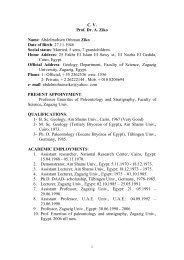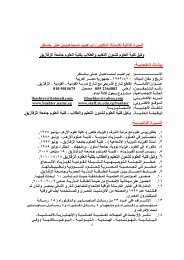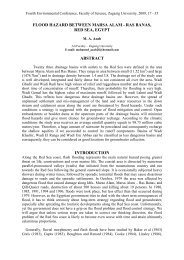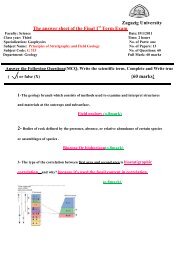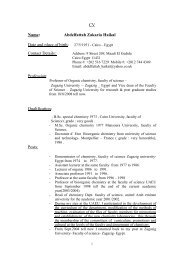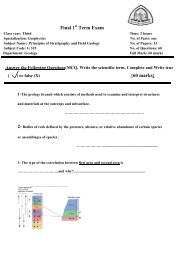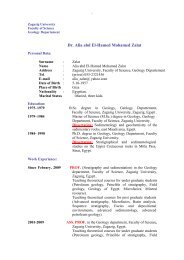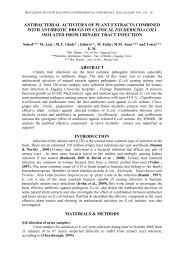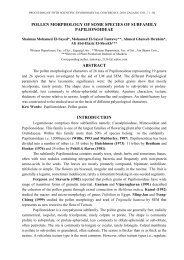prevalence of toxigenic bacteria in some egyptian food abstract ...
prevalence of toxigenic bacteria in some egyptian food abstract ...
prevalence of toxigenic bacteria in some egyptian food abstract ...
You also want an ePaper? Increase the reach of your titles
YUMPU automatically turns print PDFs into web optimized ePapers that Google loves.
110PREVALENCE OF TOXIGENIC BACTERIA IN SOME EGYPTIAN FOODDeterm<strong>in</strong>ation <strong>of</strong> virulence factorsProduced hemolys<strong>in</strong>, lecith<strong>in</strong>ase and protease enzymes were determ<strong>in</strong>ed us<strong>in</strong>g agarwell diffusion assay accord<strong>in</strong>g to Re<strong>in</strong>heimer et al. (1990) and Misra and Kuila (1992).Wells <strong>in</strong> blood agar, egg yolk agar and case<strong>in</strong> agar plates were filled with 40ul aliquots <strong>of</strong>filter-sterilized (0.45µm pore size) <strong>bacteria</strong>l cultures filtrates. Plates were <strong>in</strong>cubated at desiredtemperature for 24 h.Molecular Biology StudiesDeterm<strong>in</strong>ation <strong>of</strong> cellular and extracellular prote<strong>in</strong> patterns us<strong>in</strong>g SDS-PAGE techniqueaccord<strong>in</strong>g to Laemmli (1970) and LKB Application note (1977).The exam<strong>in</strong>ed <strong>bacteria</strong>l stra<strong>in</strong>s were grown <strong>in</strong> 50ml Tryptone Soya Broth (TSB) at30 o C for 24 hours. Bacterial cells were harvested by centrifugation and the filtrates wereseparated for further extraction <strong>of</strong> extracellular prote<strong>in</strong>s. Bacterial pellets were washed twiceus<strong>in</strong>g sterile bi-distilled water. The <strong>bacteria</strong>l pellets were sonicated, re-suspended <strong>in</strong> steriledistilled water and centrifuged. The precipitated cellular prote<strong>in</strong>s were then separated and resuspended<strong>in</strong> phosphate buffer pH 7.The supernatants separated by centrifugation were concentrated100 times us<strong>in</strong>g 70% saturated(NH 4 ) 2 . SO 4 . The precipitated extracellular prote<strong>in</strong>s were re-suspended <strong>in</strong> phosphate bufferpH 7. 100μl <strong>of</strong> each cellular and extracellular prote<strong>in</strong> preparations were mixed with 50μl <strong>of</strong>treatment buffer separately and boiled <strong>in</strong> a water bath for 5 m<strong>in</strong>utes then <strong>in</strong>jected <strong>in</strong>to thewells <strong>of</strong> the prepared polyacrylamide gel. The molecular weights <strong>of</strong> separated prote<strong>in</strong>s weredeterm<strong>in</strong>ed by electrophoresis compared with marker prote<strong>in</strong>s hav<strong>in</strong>g molecular weightsrang<strong>in</strong>g between 14 to 116 kDa after sta<strong>in</strong><strong>in</strong>g with commasie blue. The molecular weights <strong>of</strong>separated prote<strong>in</strong>s were determ<strong>in</strong>ed by electrophoresis compared with marker prote<strong>in</strong>s hav<strong>in</strong>gmolecular weights rang<strong>in</strong>g between 14 to 116 kDa after sta<strong>in</strong><strong>in</strong>g with commasie blue.DNA extraction for multiplex- PCRDNA templates <strong>of</strong> the tested <strong>bacteria</strong>l cultures were prepared from 4-hours cultures grown <strong>in</strong>TSB at 30 o C separately accord<strong>in</strong>g to the method described by Ngamwongsatit et al. (2008).Specific multiplex PCR amplification conditions for Staphylococcus aureus enterotox<strong>in</strong>sgenes sea, seb, sec, sed & see accord<strong>in</strong>g to P<strong>in</strong>to et al. (2005).PCR amplifications were conducted <strong>in</strong> a solution conta<strong>in</strong><strong>in</strong>g 1XPCR buffer (10mMTris–HCl, pH 8.8; 1.5mM MgCl 2 ,50 mM KCl,0.1% Triton X-100), 100 mM <strong>of</strong> each dNTP,1mM <strong>of</strong> each primer and 0.5U <strong>of</strong> thermostable DNA polymerase (DyNAzyme II DNApolymerase, F<strong>in</strong> enzymes Oy,F<strong>in</strong>land) and 5 μl <strong>of</strong> DNA template, <strong>in</strong> a f<strong>in</strong>al volume <strong>of</strong> 50μl.Amplification conditions were: 5 m<strong>in</strong> at 94 o C, 35 cycles <strong>of</strong> 30 s at 94 o C,45 s at thecorrespond<strong>in</strong>g anneal<strong>in</strong>g temperature and 45 s at 72 o C and a f<strong>in</strong>al extension <strong>of</strong> 10 m<strong>in</strong> at 72o C. PCR products (15 ml) were electrophoresed through 2% agarose gel <strong>in</strong> TAE buffer(40mM Tris–acetate,pH 8.0; 1mM Na 2 EDTA). Amplicons sizes were estimated us<strong>in</strong>g 100bpDNA ladder (Amersham, USA) run on the same gel.The oligonucleotides used <strong>in</strong> this work, their sequences, target positions and size <strong>of</strong>amplification fragments are summarized <strong>in</strong> the follow<strong>in</strong>g tabulation accord<strong>in</strong>g to (P<strong>in</strong>to et al.,2005) :



